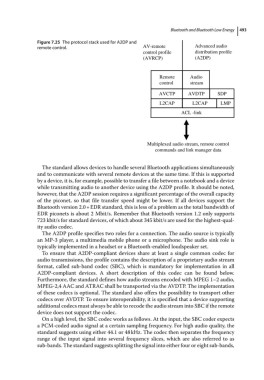Page 507 - From GMS to LTE
P. 507
Bluetooth and Bluetooth Low Energy 493
Figure 7.25 The protocol stack used for A2DP and
remote control. AV-remote Advanced audio
control profile distribution prole
(AVRCP) (A2DP)
Remote Audio
control stream
AVCTP AVDTP SDP
L2CAP L2CAP LMP
ACL -link
Multiplexed audio stream, remote control
commands and link manager data
The standard allows devices to handle several Bluetooth applications simultaneously
and to communicate with several remote devices at the same time. If this is supported
by a device, it is, for example, possible to transfer a file between a notebook and a device
while transmitting audio to another device using the A2DP profile. It should be noted,
however, that the A2DP session requires a significant percentage of the overall capacity
of the piconet, so that file transfer speed might be lower. If all devices support the
Bluetooth version 2.0 + EDR standard, this is less of a problem as the total bandwidth of
EDR piconets is about 2 Mbit/s. Remember that Bluetooth version 1.2 only supports
723 kbit/s for standard devices, of which about 345 kbit/s are used for the highest‐qual-
ity audio codec.
The A2DP profile specifies two roles for a connection. The audio source is typically
an MP‐3 player, a multimedia mobile phone or a microphone. The audio sink role is
typically implemented in a headset or a Bluetooth‐enabled loudspeaker set.
To ensure that A2DP‐compliant devices share at least a single common codec for
audio transmissions, the profile contains the description of a proprietary audio stream
format, called sub‐band codec (SBC), which is mandatory for implementation in all
A2DP‐compliant devices. A short description of this codec can be found below.
Furthermore, the standard defines how audio streams encoded with MPEG 1–2 audio,
MPEG‐2,4 AAC and ATRAC shall be transported via the AVDTP. The implementation
of these codecs is optional. The standard also offers the possibility to transport other
codecs over AVDTP. To ensure interoperability, it is specified that a device supporting
additional codecs must always be able to recode the audio stream into SBC if the remote
device does not support the codec.
On a high level, the SBC codec works as follows. At the input, the SBC coder expects
a PCM‐coded audio signal at a certain sampling frequency. For high audio quality, the
standard suggests using either 44.1 or 48 kHz. The codec then separates the frequency
range of the input signal into several frequency slices, which are also referred to as
sub‐bands. The standard suggests splitting the signal into either four or eight sub‐bands,

